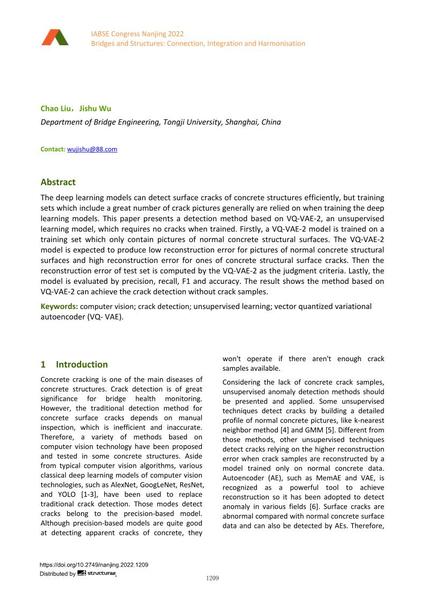Detection of Concrete Structural Surface Cracks Based on VQ-VAE-2

|
|
|||||||||||
Détails bibliographiques
| Auteur(s): |
Chao Liu
(Department of Bridge Engineering, Tongji University, Shanghai, China)
Jishu Wu (Department of Bridge Engineering, Tongji University, Shanghai, China) |
||||
|---|---|---|---|---|---|
| Médium: | papier de conférence | ||||
| Langue(s): | anglais | ||||
| Conférence: | IABSE Congress: Bridges and Structures: Connection, Integration and Harmonisation, Nanjing, People's Republic of China, 21-23 September 2022 | ||||
| Publié dans: | IABSE Congress Nanjing 2022 | ||||
|
|||||
| Page(s): | 1209-1215 | ||||
| Nombre total de pages (du PDF): | 7 | ||||
| DOI: | 10.2749/nanjing.2022.1209 | ||||
| Abstrait: |
The deep learning models can detect surface cracks of concrete structures efficiently, but training sets which include a great number of crack pictures generally are relied on when training the deep learning models. This paper presents a detection method based on VQ-VAE-2, an unsupervised learning model, which requires no cracks when trained. Firstly, a VQ-VAE-2 model is trained on a training set which only contain pictures of normal concrete structural surfaces. The VQ-VAE-2 model is expected to produce low reconstruction error for pictures of normal concrete structural surfaces and high reconstruction error for ones of concrete structural surface cracks. Then the reconstruction error of test set is computed by the VQ-VAE-2 as the judgment criteria. Lastly, the model is evaluated by precision, recall, F1 and accuracy. The result shows the method based on VQ-VAE-2 can achieve the crack detection without crack samples. |
||||
| Copyright: | © 2022 International Association for Bridge and Structural Engineering (IABSE) | ||||
| License: | Cette oeuvre ne peut être utilisée sans la permission de l'auteur ou détenteur des droits. |
||||
